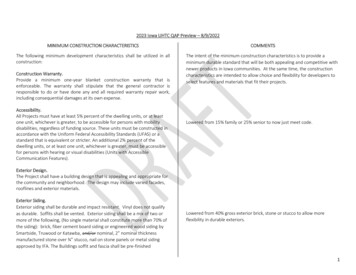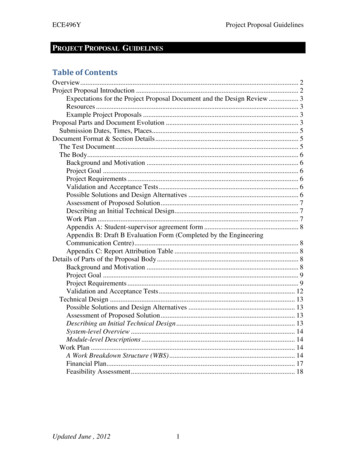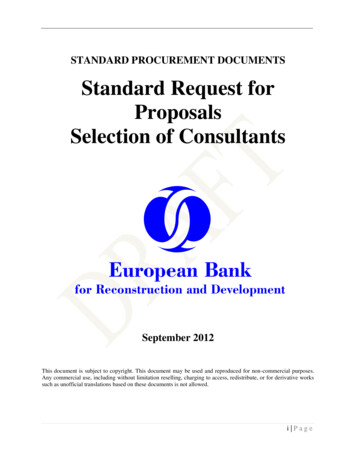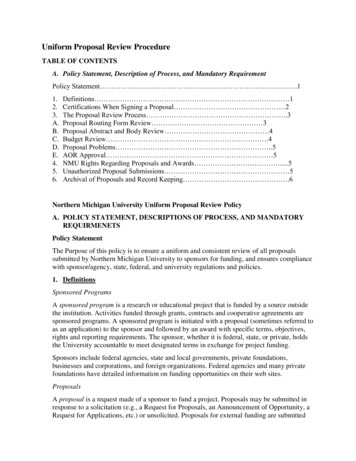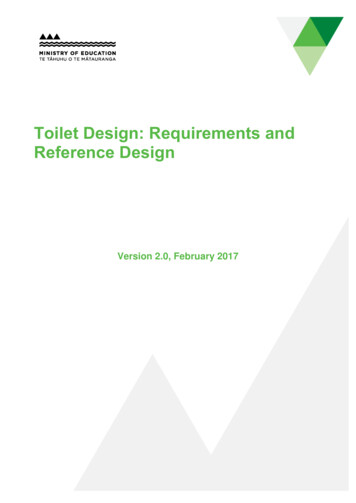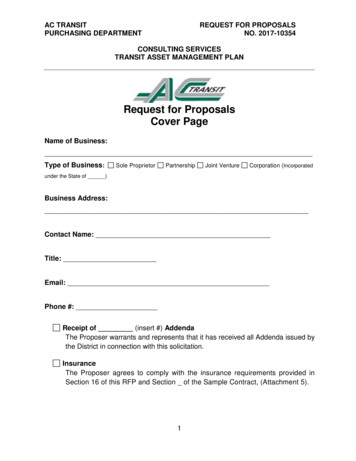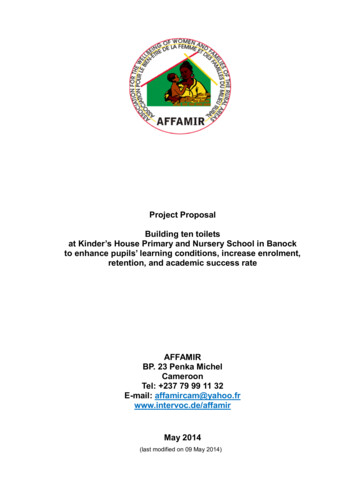
Transcription
Project ProposalBuilding ten toiletsat Kinder’s House Primary and Nursery School in Banockto enhance pupils’ learning conditions, increase enrolment,retention, and academic success rateAFFAMIRBP. 23 Penka MichelCameroonTel: 237 79 99 11 32E-mail: affamircam@yahoo.frwww.intervoc.de/affamirMay 2014(last modified on 09 May 2014)
Page 2 of 5Project Proposal: Building ten toilets at Kinder’s House in BanockPage 2 of 5Content1Summary . 22The Organisation . 22.12.22.32.43The Project . 33.13.24Name and brief description of the organisation .2Representative of the organisation .3Other contact persons .3Contact details of the organisation .3Water and sanitation problems of the local area .3Plan for resolving these water and sanitation Objective. 3Details . 3Prospective impact. 3Direct and indirect beneficiaries of the project . 4Cost estimate. 4Stakeholder participation. 4Sustainability . 5Time Schedule . 5Bank Account . 51 SummaryThe project aims at enhancing pupils’ learning conditions through the construction of ten (10) toilets at theKinder’s House Primary and Nursery School in Banock. Currently 480 pupils are sharing two toilets which arealmost full. Its implementation will solve the toilet shortage problem but also other related problems – teachers’poor productivity, pupils’ poor academic performances, drop out and low self-esteem. It will contribute toincreasing the enrolment, retention and academic success rate of pupils.2 The Organisation2.1Name and brief description of the organisationThe “Association pour le bien-être de la Femme et des Familles du Milieu Rural” (AFFAMIR) is a developmentorganisation based in Penka Michel, a rural municipality in the western region of Cameroon. It aims at contributingto societal and economic change, to the fight against structural causes of poverty, and to the reduction of powerimbalances. Strategically, the organisation uses education and training as entry points because we believe themore people are empowered, the more they are able to hold the reins of their destiny and live the life they desireand deserve.The main objective of AFFAMIR is to contribute to the fight against the root causes of poverty in this ruralmunicipality through: Improvement of the provision of educational services:creation and equipment of nursery and primary schools with toilets, potable water, libraries, computerlaboratories, school buses, etc.;training in teaching methodology and skills of primary school teaching staff including the emerging teachingtechnologies;building and improving managerial capacities; mentoring, research and supervision skills of primary schooladministrators; provision of teaching material; Promotion of vocational training for drop out students and the youth in order to provide quality technicalvocational and entrepreneurship training that meets the needs of the local labour market; Promotion of education for all by offering holistic and long term scholarships to underprivileged boys andgirls; Empowerment of parents and tutors and equipping them with resources, practical tools and tips theyneed to fiercely advocate for a better education for their children, ensure their academic and social success,meet the challenges of today’s parenting, and ensure a healthy and responsible life for their children. Sexual and reproductive education of teenagers.
Page 3 of 52.2Project Proposal: Building ten toilets at Kinder’s House in BanockPage 3 of 5Representative of the organisationCéline Clémence MAGNECHE NDE SIKA, Founder and National Coordinator; affamircam@yahoo.fr2.3Other contact personsNde Serge Patrick, Financial and Administrative Officer, didicoulpat2013@yahoo.frEmmanuel Kamtchebu, Member, Board of Directors, kamtchemma@yahoo.fr2.4Contact details of the organisationPostal Mailing address: B.P. 23, Penka Michel, CameroonPhone: 237 99 90 28 65; 237 79 99 11 32Provisional website: www.intervoc.de/affamir3 The Project3.1Water and sanitation problems of the local areaThere is acute shortage of toilets and a serious deterioration of the existing ones.The background is parent’s increasing awareness of the importance of education in people and communities’lives. This has lead to sudden increase in pupils’ enrolment rate at the Kinder’s House Nursery and PrimarySchool in Banock. The facilities which the school offers do not exist in other schools in the community. Theexcellent performance of our pupils is a clear indicator.Currently, the 480 pupils and the personnel (23 persons) are using three pit latrines constructed in 2004, whichare almost full. One of the toilet is for the teachers and the support staff (men and women), and two are for the480 pupils (boys and girls). This situation contributes significantly to pupils’ absenteeism and dropout from school.Parents are reluctant to send their children, and in particular girls, to school because pupils will queue for hoursand fight to use the very few existing toilets. To this we should add the sanitary issue. Because boys and girlsshare the same toilets, there is a risk for the girls to be infected when boys stand up while using the toilets. Thereis also this situation where pupils defecate behind the classrooms or in class during the lessons because they fearto be harassed if they go to the toilets, or because they are tired to queue. The result is they become easy targetto other students who bully them, which contributes to lowering their self-esteem.Small children are not able to wait for long time. They always dirty their pants and wet themselves, adding morework to teachers and creating conflicts between teachers and the administration, and making it difficult toinstructors to effectively follow the curriculum. The challenge we are facing now is to build new, more andadequate latrine facilities for males and females, for boys and girls, all separated.3.2Plan for resolving these water and sanitation problemsThe plan is to build ten toilets at Kinder’s House Primary and Nursery School in Banock to enhance pupils’learning conditions, increase enrolment, retention, and academic success rate.3.2.1ObjectiveTo provide a safe, healthy and conducive learning environment that will increase the enrolment, retention, andacademic success rate of boys and girls.3.2.2DetailsConstruction of ten spaciously ventilated latrines with cement blocks, tiles on the walls and the floor, toilet tissueholders, and sinks and water to wash hands. After the construction, there will be ten toilets in total: two for theteaching and support staff, four for girls and four for boys.3.2.3Prospective impactSome of the expected impacts are: Higher pupils’ and girls’ enrolment, retention and academic success rate Girls will feel more confident, stay the necessary years in school to achieve their objective of beingeducated Improvement of the academic performances of the pupils Improvement of pupils’ self-esteem and well-being
Page 4 of 5Project Proposal: Building ten toilets at Kinder’s House in BanockPage 4 of 5Improvement of relationships between instructors and the school administration Teachers’ high productivity Better sanitation and hygiene conditions. The implementation of the project will therefore effectively contribute to the fight against one of the structuralcauses of poverty in the community that, in this case, is the low education rate.3.2.4Direct and indirect beneficiaries of the project503 persons are the direct beneficiaries of the project: 480 students 23 staff.The indirect beneficiaries of the project are people who participate in annual teachers training workshops andseminars which AFFAMIR and the Ministry of Basic Education organize on the premises of the school. Parentsand the youth who attend the summer camp organized by the organisation and its partners at the school will alsobenefit. This is about 150 additional people every year.3.2.5Cost estimateIn order to realize all the activities before, during and after the completion of the project, a total amount of5,912,772 FCFA (or 9,013 Euro) would be required. The AFFAMIR Management Committee would be able tocontribute 771,231 FCFA (or 1,175 Euro). An amount of 5,141,541 FCFA (or 7,838 Euro) would need to bemobilised from external sources.CostNr1234567891011ItemAdvertisement of the construction of the toiletsMeetings and transportation of members of management committeeExcavationsFoundationsReinforced concrete and building workRoof structure (woodwork & 6ItemTotal cost of completing the project (14)Contribution by the Management CommitteeExternal funding required (15 minus 16)FCFA5,912,772771,2315,141,541Euro 19,0131,1757,838Stakeholder participationThe school has a Management Committee composed of one representative of the teachers, one representative ofAFFAMIR, and three representatives of pupils’ parents. They meet once a month to discuss the management ofthe school, suggest strategies to improve and create better learning conditions for pupils, and make sure thatconditions are met for pupils’ academic success and personal growth. During one of these participative meetings,they identified and discussed this critical issue of the toilets, and decided that it is necessary to come up withsustainable solutions. AFFAMIR helped to write this current project proposal based on the data collected duringthe meetings.1Exchange rate: 1 Euro 656 FCFA (fixed rate)
Page 5 of 5Project Proposal: Building ten toilets at Kinder’s House in BanockPage 5 of 5The school already has sufficient space to build the toilets.The Management Committee is prepared to cover the following cost: Meetings and transportation fees of the Management and Steering Committee members Labour cost of the construction (10 % of the total cost of the project).The Members of the Management Committee will cover these expenses from their private pockets. They will alsocoordinate, supervise and monitor the construction of the toilets.They will elect among themselves a Steering Committee of two members who will coordinate, supervise andmonitor the construction of the toilets. Once per month, the Members of the Steering Committee will present areport of the construction to the Management Committee.3.2.7SustainabilityThe project is a component of a larger project, the Nursery and Primary School, which was created in 2004 aspart of a social transformation program. The running costs of the school are being covered by the school fees theparents pay every year. These funds are managed by the Management Committee. The school is there to last.Once the construction of the toilets is finished, it will be managed by the Management Committee. Its runningcosts – electricity, water, cleaning products, toilet paper, etc. – will be covered from the school fees.3.2.8Time ScheduleActivityResponsibleAppointment members of theManagement Committeesteering committeeof the schoolAdvertisement of the construction Management Committeeof the projectSelection of the contractor and Management Committeesigning the contract with the latterBuy construction materialManagement CommitteeBuilding of the ten toiletsThe contractor and his teamCoordination, supervision, and Steering Committeemonitoring of the projectSupervision meetings andManagement Committee;evaluation of the constructionSteering CommitteeInstallation of electricity and water The contractor and his teamin the newly constructed toiletsFinal evaluation of the projectManagement CommitteeWriting of the final report andAFFAMIRsubmission to the donorsMonth 1 Month 2 Month 3 Month 4 Month 5 Month 6 Month 74 Bank AccountName of Account HolderAssociation pour le Bien-être de la Femme et des Familles du Milieu RuralAddress of Account HolderB.P. 23, Penka Michel, CameroonName of BankSociété Générale de Banques au Cameroun (SGBC)Branch NameSGBC BafoussamAccount No.10003 00500 16050161593 - 36IBAN CodeCM21SWIFT CodeSGCMCMCXAddress of Bank78 Rue Joss, Douala, Cameroon
Page 4 of 5 Project Proposal: Building ten toilets at Kinder's House in Banock Page 4 of 5 Improvement of relationships between instructors and the school administration Teachers' high productivity Better sanitation and hygiene conditions. The implementation of the project will therefore effectively contribute to the fight against one of the structural
